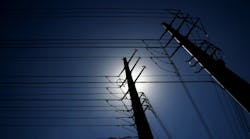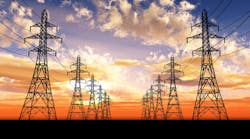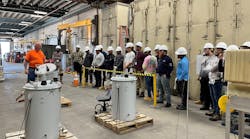Cascading failures present severe threats to power grid reliability and security, and Marianna Vaiman will teach participants at the IEEE PES General Meeting how to prevent or deal with this threat to reliability.
Vaiman has more than 20 years of experience in power systems studies. She is an executive vice-president and a co-founder of V&R Energy, a provider of software solutions for the electric power industry. She holds BS and MS in EE from Moscow University of Transportation Engineering, Moscow, Russia.
She presently manages V&R Energy's Smart Grid Projects and is responsible for software development of Physical and Operational Margins (POM) Suite of applications and Region Of Stability Existence (ROSE) software, as well as coordination of POM and ROSE users group.
Vaiman will be presenting a tutorial on Understanding Cascading Phenomenon: Methodologies and Industry Practice for Analysis of Cascading Failures at the IEEE PES General Meeting next week in Denver. This tutorial developed by the IEEE Cascading Failure Working Group provides an overview of the cascading phenomenon and explains methods, technologies, and tools that are currently being used to predict, detect, mitigate and restore from cascading failures. This is the first PES GM tutorial dedicated solely to the subject of cascading outages.
This full-day tutorial covers the power system cascading concepts, models, relevant standards and existing industry practices for analysis of cascading failures in planning and operating environments. Close attention is given to the new technologies, such as synchrophasor technology, for better detection and mitigation of cascading outages. The tutorial also explains the root causes and mechanisms of propagation of the past blackouts, and discusses the lessons learned. The tutorial, taught by well recognized experts from industry and academia, is intended for power system engineers, regulators, transmission owners, power engineering students and academics. Topics include:
- Overview of Cascading Outages Phenomenon
- Framework for Analysis of Cascading Outages
- Current Tools and Emerging Technologies for Prediction and Detection of Cascading Outages
- Current Tools and Emerging Technologies for Prevention and Mitigation of Cascading Outages
- Industry Experience in the Analysis of Cascading Outages
- Restoration from Cascading Failures
- Analysis of Past Blackouts Caused by Cascading Outages: Lessons Learned
Following is a Q&A with Vaiman on how cascading outage analysis is a crucial topic for the industry:
Q: What instructors will be involved in the full-day tutorial on cascading phenomena?
Instructors for the tutorial are the leading experts across the globe representing the industry and academia: Emanuel Bernabeu, PJM; Bob Cummings, NERC; Ian Dobson, Iowa State University; Michael Forte, Con Edison of New York; Paul Hines, University of Vermont; Mladen Kezunovic, Texas A&M University; Eugene Litvinov, ISO New England; Vahid Madani, Pacific Gas & Electric; Damir Novosel, Quanta Technology; Milorad Papic, Idaho Power Company; Ryan Quint, NERC; Dede Subakti, California ISO; Vladimir Terzija, University of Manchester; Marianna Vaiman, V&R Energy; Vijay Vittal, Arizona State University; and Brett Wangen, Peak Reliability.
Each team member brings his/her extensive experience, vision and understanding of the subject to the class. We’ll look at cascading phenomenon from different angles to offer our students a comprehensive overview of methodologies and industry practice for analysis of cascading failures.
I’m honored to be a part of this “Superteam”, and organize the tutorial on behalf of IEEE Cascading Failure Working Group (CFWG).
Q: How does your current position qualify you to present this topic?
My current position, as well as past experience, allows me to combine understanding of the needs of the industry through daily contact with our users in electric utilities and regional organizations and in-depth research on cascading failures that I’m involved in. Symbiosis of practical and theoretical aspects will make the class interesting and useful to the audience.
Q: Why is the topic of cascading phenomena so important to the industry?
Cascading is one of the most complex phenomena occurring in power systems, and encompasses many fundamental power system concepts, such as steady-states stability analysis, transient stability analysis, system oscillations, modeling of protection systems and their coordination, control actions, islanding, system restoration, and many others. Until recently, cascading outage analysis was either not performed or very rarely performed at utilities and regional organizations. We, as the industry, are in the process of learning and understanding how to perform these studies. The tutorial will provide a theoretical background of cascading outages; overview of methods and tools for analysis of cascading; frameworks for performing cascading outages analysis at various utilities; discussion of NERC standards related to cascading analysis, system restoration best practices, and lessons learned from recent blackouts.
Q: When and why did you decide to go into your particular career field?
It was an easy decision – I followed my father’s footsteps. Since I learned the words “the Second Lyapunov method” before I learned to walk, it seemed natural to pursue this path and continue our family’s engineering tradition.
Q:. Best thing about your job right now?
Seeing V&R’s software tools being used in real-time to help make operational decisions. It’s fascinating to be engaged in every step of transforming a concept, an idea into a useful operational tool. Also, to be involved in transferring cascading outages analysis from a research concept into a practical analysis framework.
Q: What courses have you presented in the past, and what’s coming up?
In the past, I presented courses on voltage stability analysis, use of synchrophasor technology for advanced applications, cascading outages analysis, reliability analysis, and NERC compliance studies. I also teach classes on the use of V&R’s applications. I’ll keep teaching these courses. The new courses that I’ll present are on modeling and coordination of protection systems during analysis of cascading outages, and linear state estimation.
Q: What's the most important thing you’ve learned in your past experience that you want to communicate to participants?
To love what you’re doing.
Q: What do you like to do in your spare time?
After work, I spend time with my kids, work more, and volunteer for IEEE. I also like reading, going to opera, ballet, and movies with the kids, and enjoy working out.
Q: Anything else you would like to add?
I would like to thank Sue Koval and LaToya Gourdine, both with IEEE, for helping me at every step of putting the tutorial together.


